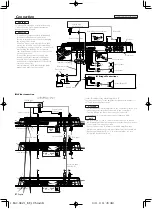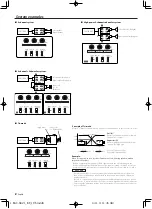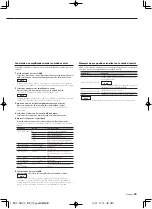
English
9
Troubleshooting Guide
What might appear to be a malfunction in your unit may just be the result of slight misoperation or miswiring. Before calling service, first check the following
table for possible problems.
PROBLEM
POSSIBLE CAUSE
SOLUTION
No sound.
(No sound from one side.)
(Blown fuse.)
• Input (or output) cables are disconnected.
• Protection circuit may be activated.
• Volume is too high.
• The speaker cord is shorted.
• Connect the input (or output) cables.
• Check connections by referring to "Protection function".
• Replace the fuse and use lower volume.
• After check the speaker cord and fixing the cause of the short,
replace the fuse.
The output level is too small
(or too large).
• The input sensitivity adjusting control is not set to the correct
position.
• Adjust the control correctly referring to "Controls".
The sound quality is bad.
(The sound is distorted.)
• The speakers wire are connected with wrong
+
/
-
polarity.
• A speaker wire is pinched by a screw in the car body.
• The switches may be set improperly.
• Connect them properly checking the
+
/
-
of the terminals
and wires well.
• Connect the speaker wire again so that it is not pinched by
anything.
• Set switches properly by referring to "System examples".
The sound does not change
even when you have changed
it with the Amplifier Control.
• The AMP CONT has been turned "OFF".
• The filtered band has been controlled by the Amplifier Control.
• Turn the AMP CONT "ON".
• Turn the filter Off.
The set value cannot be
changed by the Amplifier
Control of the unit.
• The AMP Control of the Center Unit is being used.
• Release the AMP Control mode of the Center Unit.
The Amplifier Control cannot
be operated from the Center
Unit.
• An incorrect ID number is used for the Master amplifier.
• The ID number of the amplifier has been changed.
• Always set the ID number of the Master amplifier to "0".
• After you have changed the ID number of an amplifier, turn Off
the POWER switch of the Center Unit first, then turn it On again.
Specifications
Specifications subject to change without notice.
Audio Section........................................................................................................................KAC-X621 KAC-X521
RMS Power Output (+B = 14.4 V, CEA-2006)
Normal (4 Ω/2ch) (1.0 % THD+N)........................................................................................................................................... 179 W 165 W
Normal
(2 Ω/2ch) (1.0 % THD+N)........................................................................................................................................... 305 W 254 W (1 kHz)
Bridged (4 Ω) (1.0 % THD+N).................................................................................................................................................... 612 W 505 W × 1
Dynamic Power (+B = 14.4 V, CEA-2006) .......................................................................................................................................... 191 W 170 W
Output Regulation (+B = 14.4 V, CEA-2006).......................................................................................................... under 0.3 dB (4 Ω) under 0.3 dB (4 Ω)
Signal to Noise Ratio (CEA-2006).......................................................................................................................................83 dBA (W/4 Ω) 81 dBA (W/4 Ω)
Signal to Noise Ratio
(Bypass) (CEA-2006) ...................................................................................................................83 dBA (W/4 Ω) 82 dBA (W/4 Ω)
Sensitivity (rated output) (MAX.) ..............................................................................................................................................................0.2 V 0.2 V
Sensitivity (rated output)
(MIN.) ...............................................................................................................................................................5.0 V 5.0 V
Input Impedance ............................................................................................................................................................................................ 10 kΩ 10 kΩ
Low Pass Filter Frequency (24 dB/oct.) .............................................................................................................50 – 200 Hz (variable) 50 – 200 Hz (variable)
High Pass Filter Frequency (12 dB/oct.)............................................................................................................50 – 200 Hz (variable) 50 – 200 Hz (variable)
Infrasonic Filter Frequency (24 dB/oct.).............................................................................................................................................. 15 Hz 15 Hz
Frequency Response (+0, –3 dB)...........................................................................................................................................5 Hz – 70 kHz 5 Hz – 70 kHz
Audio Section......................................................................................................................KAC-PS621 KAC-PS521
Max Power Output......................................................................................................................................................................................1200 W 1000 W
Rated Power Output (+B = 12.0 V)
Normal (4 Ω) (20 Hz – 20 kHz, 0.05 % THD)..............................................................................................................100 W × 2 80 W × 2
Normal
(2 Ω) (1 kHz, 0.5 % THD) .....................................................................................................................................200 W × 2 160 W × 2
Bridged (4 Ω) (1 kHz, 0.5 % THD)....................................................................................................................................400 W × 1 320 W × 1
Rated Power Output (+B = 14.4 V)
Normal (4 Ω) (20 Hz – 20 kHz, 0.05 % THD)..............................................................................................................150 W × 2 125 W × 2
Normal
(4 Ω) (DIN : 45324 , +B = 14.4V).....................................................................................................................150 W × 2 125 W × 2
Normal
(2 Ω) (1 kHz, 0.5 % THD) .....................................................................................................................................300 W × 2 250 W × 2
Bridged (4 Ω) (1 kHz, 0.5 % THD)....................................................................................................................................600 W × 1 500 W × 1
Sensitivity (rated output) (MAX.) ..............................................................................................................................................................0.2 V 0.2 V
Sensitivity (rated output)
(MIN.) ...............................................................................................................................................................5.0 V 5.0 V
Input Impedance ............................................................................................................................................................................................ 10 kΩ 10 kΩ
Low Pass Filter Frequency (24 dB/oct.) .............................................................................................................50 – 200 Hz (variable) 50 – 200 Hz (variable
High Pass Filter Frequency (12 dB/oct.)............................................................................................................50 – 200 Hz (variable) 50 – 200 Hz (variable)
Infrasonic Filter Frequency (24 dB/oct.).............................................................................................................................................. 15 Hz 15 Hz
Frequency Response (+0, –3 dB)...........................................................................................................................................5 Hz – 70 kHz 5 Hz – 70 kHz
Signal to Noise Ratio...................................................................................................................................................................................105 dB 105 dB
Amplifier Control Section (EQ) ................................................................................KAC-X621/PS621 KAC-X521/PS521
Bass frequency .............................................................................................................................................................. 60 / 80 / 100 / 200 Hz 60 / 80 / 100 / 200 Hz
Bass level ........................................................................................................................................................................................... -15 — +15 dB -15 — +15 dB
Bass Q factor.................................................................................................................................................................1.00 / 1.25 / 1.50 / 2.00 1.00 / 1.25 / 1.50 / 2.00
Treble frequency ............................................................................................................................................................. 10 / 12 / 15 / 17 kHz 10 / 12 / 15 / 17 kHz
Treble level ....................................................................................................................................................................................... -15 — +15 dB -15 — +15 dB
General ......................................................................................................................KAC-X621/PS621 KAC-X521/PS521
Operating Voltage ........................................................................................................................................... 14.4 V (11 – 16 V allowable) 14.4 V (11 – 16 V allowable)
Current Consumption (+B = 12.0 V, 1 kHz, 10 % THD, 4 Ω).........................................................................................................40 A 37 A
Dimensions (W × H × D) ..........................................................................................................................................446 × 61 × 259.5 mm 386 × 61 × 259.5 mm
..............................................................................................................................................................
17-5/8 × 2-3/8 × 10-3/16 inch 15-3/16 × 2-3/8 × 10-3/16 inch
Installation Size (W × H × D) ..................................................................................................................................... 446 × 61 × 265 mm 386 × 61 × 265 mm
.................................................................................................................................................................
17-5/8 × 2-3/8 × 10-3/8 inch 15-3/16 × 2-3/8 × 10-3/8 inch
Weight .......................................................................................................................................................................................... 4.42 kg (9.74 lbs) 3.83 kg (8.44 lbs)
1.KAC-X621̲KE̲1US.indd
04.1.9, 11:45 AM
9








































